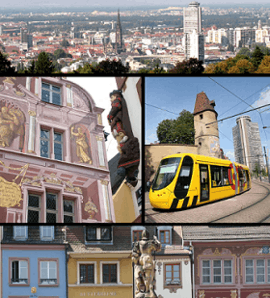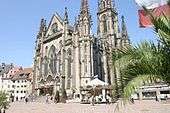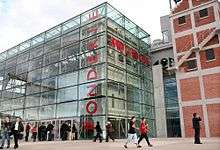Mulhouse
| Mulhouse Mülhausen / Milhüsa | |||
|---|---|---|---|
 | |||
| |||
 Mulhouse | |||
|
Location within Alsace region  Mulhouse | |||
| Coordinates: 47°45′N 7°20′E / 47.75°N 7.34°ECoordinates: 47°45′N 7°20′E / 47.75°N 7.34°E | |||
| Country | France | ||
| Region | Alsace-Champagne-Ardenne-Lorraine | ||
| Department | Haut-Rhin | ||
| Arrondissement | Mulhouse | ||
| Intercommunality | Mulhouse Alsace Agglomération | ||
| Government | |||
| • Mayor (2010–2014) | Jean Rottner (UMP) | ||
| Area1 | 22.18 km2 (8.56 sq mi) | ||
| Population (2009)2 | 111,156 | ||
| • Density | 5,000/km2 (13,000/sq mi) | ||
| INSEE/Postal code | 68224 / 68100, 68200 | ||
| Dialling codes | 0389, 0369 | ||
| Elevation |
232–338 m (761–1,109 ft) (avg. 240 m or 790 ft) | ||
|
1 French Land Register data, which excludes lakes, ponds, glaciers > 1 km² (0.386 sq mi or 247 acres) and river estuaries. 2 Population without double counting: residents of multiple communes (e.g., students and military personnel) only counted once. | |||
Mulhouse (pronounced: [myluz]; Alsatian: Milhüsa or Milhüse, [mɪlˈyːzə]; German: Mülhausen; i.e. mill house) is a city and commune in eastern France, close to the Swiss and German borders.
With a population of 110,514[1] and 278,206 inhabitants in the metropolitan area[2] in 2006, it is the largest city in the Haut-Rhin département, and the second largest in the Alsace region after Strasbourg. Mulhouse is the principal commune of the 32 making up the Communauté d'agglomération Mulhouse Alsace Agglomération (M2A, population 252,000).[3]
Mulhouse is famous for its museums, especially the Cité de l’Automobile (also known as "Musée national de l’automobile") and the Musée Français du Chemin de Fer (also known as "Cité du train"), respectively the largest automobile and railway museums in Europe. An industrial town nicknamed "the French Manchester",[4] Mulhouse is also the main seat of the Upper Alsace University, where the secretariat of the European Physical Society can be found.
Administration
Mulhouse is the chief city of an arrondissement of the Haut-Rhin département, of which it is a sub-prefecture.
History
Legends mention the origin of the town in 58 BC, but the first written records of Mulhouse date from the twelfth century. It was part of the southern Alsatian county of Sundgau in the Holy Roman Empire. From 1354–1515 Mulhouse was part of the Décapole, an association of ten Free Imperial Cities in Alsace. The city joined the Swiss Confederation as an associate in 1515 and was therefore not annexed by France in the Peace of Westphalia in 1648 like the rest of the Sundgau. An enclave in Alsace, it was a free and independent Calvinist republic, known as Stadtrepublik Mülhausen, associated with the Swiss Confederation until, after a vote by its citizens on 4 January 1798, it became a part of France in the Treaty of Mulhouse signed on 28 January 1798, during the Directory period of the French Revolution.
Starting in the middle of the eighteenth century, the Koechlin family pioneered cotton cloth manufacturing; Mulhouse became one of France’s leading textile centers in the nineteenth century. André Koechlin (1789–1875) built machinery and started making railroad equipment in 1842. The firm in 1839 already employed 1,800 people. It was one of the six large French locomotive constructors until the merger with Elsässische Maschinenbau-Gesellschaft Grafenstaden in 1872, when the company became Société Alsacienne de Constructions Mécaniques.[5]
After the Prussian victory in the Franco-Prussian War (1870-1871) Mulhouse was annexed to the German Empire as part of the territory of Alsace-Lorraine (1871–1918). The city was briefly occupied by French troops on 8 August 1914 at the start of World War I, but they were forced to withdraw two days later in the Battle of Mulhouse. The citizens of Alsace who unwisely celebrated the appearance of the French army, were left to face German reprisals. Alsace-Lorraine was invaded and annexed by France after World War I. Although never formally restored to Germany after the Battle of France in 1940, it was occupied by German forces until returned to French control at the end of the war in May 1945.
The town's development was stimulated first by the expansion of the textile industry and tanning, and subsequently by chemical and engineering industries from the mid 18th century. Mulhouse was for a long time called the French Manchester. In consequence, the town has enduring links with Louisiana, from which it imported cotton, and also with the Levant. The town's history also explains why its centre is relatively small.
Geography
Two rivers run through Mulhouse, the Doller and the Ill, both tributaries of the Rhine. Mulhouse is approximately 100 kilometres (62 miles) away from Strasbourg and Zürich; it is 350 km (217 mi) away from Milan and about 340 km (211 mi) from Frankfurt. It shares an international airport with Basel, Switzerland and Freiburg, Germany, which is called EuroAirPort.[6]
Climate
| Climate data for Mulhouse (1981–2010 averages) | |||||||||||||
|---|---|---|---|---|---|---|---|---|---|---|---|---|---|
| Month | Jan | Feb | Mar | Apr | May | Jun | Jul | Aug | Sep | Oct | Nov | Dec | Year |
| Record high °C (°F) | 18.8 (65.8) |
21.7 (71.1) |
25.7 (78.3) |
30.0 (86) |
32.8 (91) |
37.0 (98.6) |
38.8 (101.8) |
39.1 (102.4) |
33.7 (92.7) |
31.0 (87.8) |
23.4 (74.1) |
19.9 (67.8) |
39.1 (102.4) |
| Average high °C (°F) | 4.9 (40.8) |
6.8 (44.2) |
11.5 (52.7) |
15.5 (59.9) |
19.9 (67.8) |
23.3 (73.9) |
25.9 (78.6) |
25.5 (77.9) |
21.0 (69.8) |
15.8 (60.4) |
9.2 (48.6) |
5.6 (42.1) |
15.5 (59.9) |
| Average low °C (°F) | −1.5 (29.3) |
−1.2 (29.8) |
2.0 (35.6) |
4.6 (40.3) |
9.1 (48.4) |
12.2 (54) |
14.1 (57.4) |
13.7 (56.7) |
10.3 (50.5) |
6.9 (44.4) |
2.3 (36.1) |
−0.3 (31.5) |
6.1 (43) |
| Record low °C (°F) | −23.2 (−9.8) |
−22.8 (−9) |
−16.4 (2.5) |
−6.3 (20.7) |
−3.1 (26.4) |
1.8 (35.2) |
5.1 (41.2) |
3.4 (38.1) |
−0.9 (30.4) |
−6.3 (20.7) |
−12.6 (9.3) |
−18.7 (−1.7) |
−23.2 (−9.8) |
| Average precipitation mm (inches) | 47.3 (1.862) |
44.7 (1.76) |
52.3 (2.059) |
59.0 (2.323) |
90.4 (3.559) |
73.9 (2.909) |
71.2 (2.803) |
73.2 (2.882) |
69.1 (2.72) |
68.6 (2.701) |
56.7 (2.232) |
66.4 (2.614) |
772.8 (30.425) |
| Average precipitation days | 9.3 | 8.7 | 10.0 | 9.9 | 11.6 | 10.2 | 9.8 | 10.1 | 9.0 | 10.3 | 10.1 | 10.5 | 119.7 |
| Average snowy days | 8.3 | 7.4 | 4.6 | 1.6 | 0.1 | 0.0 | 0.0 | 0.0 | 0.0 | 0.1 | 3.5 | 6.9 | 32.5 |
| Average relative humidity (%) | 84 | 81 | 75 | 72 | 74 | 74 | 72 | 76 | 80 | 84 | 85 | 84 | 78.4 |
| Mean monthly sunshine hours | 74.0 | 94.1 | 138.1 | 176.1 | 200.1 | 226.0 | 241.3 | 227.7 | 164.3 | 118.5 | 67.8 | 55.1 | 1,783 |
| Source #1: Météo France[7][8] | |||||||||||||
| Source #2: Infoclimat.fr (humidity and snowy days, 1961–1990)[9] | |||||||||||||
Districts
Medieval Mulhouse consists essentially of a lower and an upper town.
- The lower town was formerly the inner city district of merchants and craftsmen. It developed around the Place de la Réunion (which commemorates its reunion with France). Nowadays this area is pedestrianised.
- The upper town developed from the eighteenth century on. Previously, several monastic orders were established there, notably the Franciscans, Augustinians, Poor Clares and Knights of Malta.
- The Nouveau Quartier (New District) is the best example of urban planning in Mulhouse, and was developed from 1826 on, after the town walls had been torn down (as they were in many towns in France). It is focused around the Place de la République. Its network of streets and its triangular shape are a good demonstration of the town's desire for a planned layout. The planning was undertaken by the architects G. Stolz and Félix Fries. This inner city district was occupied by rich families and the owners of local industries, who tended to be liberal and republican in their opinions.
- The Rebberg district consists of grand houses inspired by the colonnaded residences of Louisiana cotton planters. Originally, this was the town's vineyard (the word Rebe meaning vine in German). The houses here were built as terraces in the English style, a result of the town's close relationship with Manchester, where the sons of industrialists were often sent to study.
Principal places of interest

- Hôtel de Ville (sixteenth century). The town hall was built in 1553 in the Rhenish Renaissance style. Montaigne described it as a "palais magnifique et tout doré" ("a splendid golden palace") in 1580. It is known for its trompe l'œil paintings, and its pictures of allegories representing the vices and virtues.
- Workers' quarter (mid 19th century), inspired workers' quarters in many other industrial towns.[10]
- Place de la Bourse and the building of the Société Industrielle de Mulhouse, in the Nouveau Quartier (19th century)
- Cité de l’Automobile (featuring the Schlumpf collection)
- French National Railway Museum
- Museum of Electricity (Electropolis)
- Museum of Printed Textiles (Musée de l'impression sur étoffes)
- The Parc Zoologique et Botanique de Mulhouse (botanical garden and zoo)
- Saint-Steffen Calvinist temple (1859–1869), by Jean-Baptiste Schacre
-

Temple Saint-Étienne on Place de la Réunion
-

Hôtel de Ville (Rothüs), Mulhouse
-
Société Industrielle building, Mulhouse
Principal economic activities


As early as the mid-19th century, Mulhouse was known as "the industrial capital of Alsace", the "city with a hundred chimneys" (cité aux cent cheminées) and "the French Manchester"[10]
- Automobile industry (Peugeot's Mulhouse factory is the largest employer in Alsace)
- Chemical industry (ICMD)
- Electronics (Clemessy)
- Engineering (SACM – Wärtsilä)
Transport

Air
Mulhouse is served by EuroAirport Basel-Mulhouse-Freiburg, located 25 km (16 mi) south of the town.
Rail
Gare de Mulhouse is well connected with the rest of France by train, major destinations such as Paris, Dijon, Besançon, Belfort, Strasbourg, Lyon, Marseille, Montpellier and Lille being directly possible by train. There are also some trains which operate into Switzerland, such as Basel, Bern and Zürich. There is also a train service to Frankfurt am Main in Germany. A Eurocity service connects Brussels, Luxembourg, Strasbourg and Basel; this service calls at Mulhouse.
Regional services connect Mulhouse to Colmar, Strasbourg, Basel, Belfort, Kruth and Freiburg im Breisgau.
Urban transport
Transport within Mulhouse is provided by Soléa and comprises a network of buses together with the city's tram network, which opened on 13 May 2006. The tramway now consists of three tram lines and one tram-train line.
- Line 1 from Nouveau Bassin to Coteaux
- Line 2 from Gare Central to Châtaignier
- Line 3 from Gare Central to Lutterbach
- Tram-train line from Gare Centrale to Thann via Lutterbach
Road
Motorway A36 is the main axis connecting the city with the west of the country, to cities such as Dijon, Paris and Lyon. The A35 is the main north-south axis, connecting cities such as Strasbourg and Basel.
Miscellaneous
Notable people
Mulhouse was the birthplace of:
- Jean de Beaugrand (1584–1640), lineographer and mathematician
- Serge Blenner (born 1955), composer and synthesist
- Jean Brenner (1937–2009), painter
- Karl Brandt (1904–1948), personal physician to Adolf Hitler and head administrator of the T-4 Euthanasia Program
- Pierre Chambon (born 1931), biologist
- Mireille Delunsch (born 1962), soprano
- Tom Dillmann (born 1989), racing driver
- Artur Dinter (1876–1948), writer and Nazi politician.
- Adrien Dollfus (1858-1921), French zoologist and carcinologist
- Alfred Dreyfus (1859–1935), French military officer best known for being the focus of the Dreyfus affair
- Huguette Dreyfus (born 1928) harpsichordist
- François Florent (born François Eichholtzer, 1937), actor, founder of the Cours Florent
- Georges Friedel (1865–1933), mineralogist, son of Charles Friedel
- Charles Frédéric Girard (1822–1895), biologist specializing on ichthyology and herpetology
- Katia and Maurice Krafft, volcanologists
- Johann Heinrich Lambert (1728–1777), mathematician, physicist and astronomer
- Friedrich Janz (1898-1964), diplomat
- Joffrey Lauvergne (born 1991), basketball player
- Friedrich Wilhelm Levi (1888–1966), mathematician
- François Loeser (born 1958), mathematician
- Paul Meyer (born 1965), clarinetist
- Véronique North-Minca (born 1953), diplomat
- Thierry Omeyer (born 1976), handball goalkeeper
- Marc Pfertzel (born 1981), football player
- Pierre Probst (1913–2007), comic and children book artist
- Napoléon Henri Reber (1807–1880), composer
- Daniel Roth (born 1942), organist, composer and pedagogue
- Franz Eugen Schlachter (1859–1911), revivalist preacher, classical scholar and translator of the Schlachter Bible.
- Christiane Scrivener (born 1925), EU-Commissioner
- Daniel Schlumberger (1904-1972), archaeologist and professor of Near Eastern Archaeology at the University of Strasbourg and later the Princeton University.
- Jean Schlumberger (1907–1987) Jewelry designer at Tiffany & Co
- René Schützenberger (1860–1916), painter
- Frank Ténot (1925–2004), press agent, pataphysician and jazz critic
- Vitaa (born 1983), singer
- Pierre Weiss (1865–1940), physicist
- Alfred Werner (1866–1919), Nobel Prize in Chemistry 1913
- Robert Wyler (1902–1971), film producer
- William Wyler (1902–1981), award-winning motion picture director
- Jean-Marc Savelli (born at Mulhouse in 1955), a virtuoso concert pianist
- Antar Yahia (born 1982), football player
- Georges Zipélius (1808-1890), illustrator
- Other notable residents
- Adolphe Braun (1812–1877), photographer
- Alfred de Glehn (1848–1936), designer of steam locomotives
- Armando Thiriet Koenig (1882-1956), Industrial Engineer, Director of AEG Madrid in 1919, established an AEG subsidiary in Seville in the early 1920s
Mayors of Mulhouse
- Jean Rottner (2010–present)
- Jean-Marie Bockel (1989-2010)
- Joseph Klifa (1981–1989)
- Emile Muller (1956–1981)
International relations
Twin towns – sister cities
Mulhouse is twinned with:
|
References
- ↑ Commune : Mulhouse (68224) on INSEE
- ↑ Aire urbaine 1999 : Mulhouse (031) on INSEE
- ↑ Mulhouse Alsace Agglomération / Conseil installé hier soir , Les Dernières Nouvelles d'Alsace, 5 January 2010 (French)
- ↑ Le sex appeal industriel de Mulhouse (French)
- ↑ Michael Stephen Smith, The emergence of modern business enterprise in France, 1800–1930 (2006) p. 575.
- ↑ "Mulhouse". Tourist Office****and Conventional Bureau of Mulhouse and its Region.
- ↑ "Données climatiques de la station de Mulhouse" (in French). Meteo France. Retrieved December 27, 2015.
- ↑ "Climat Alsace" (in French). Meteo France. Retrieved December 27, 2015.
- ↑ "Normes et records 1961-1990: Bâle-Mulhouse (68) - altitude 263m" (in French). Infoclimat. Retrieved December 27, 2015.
- 1 2 Scheurer, Marie-Philippe; Lehni, Roger; Menninger, Claude: Mulhouse, Haut-Rhin − Images du Patrimoine, Le Verger, Illkirch-Graffenstaden, 1990, ISBN 2-908367-18-1 (French)
- ↑ "Town twinnings and international relations"(Italian)
External links
| Wikimedia Commons has media related to Mulhouse. |
| Wikisource has the text of The New Student's Reference Work article Mülhausen. |
- Official website (English) (French) (German)
- Official website of the Tourist Office of Mulhouse and its region – in English
- Official website of the Convention Bureau of Mulhouse and its region – in English
- The Mulhousian Ferret: High Resolution Video Guide of Mulhouse (French)
- MulhouseBienvenue.com City Guide Town of Mulhouse (French)
- Museum of Printed Textiles
- TramTrain website (English) (German)
| ||||||||||||||||||||||
|


